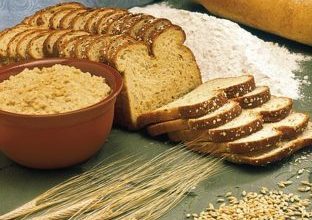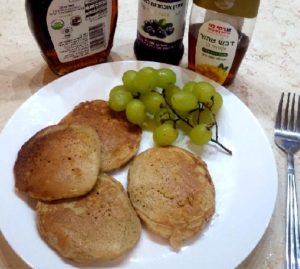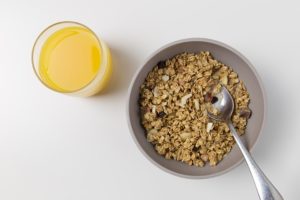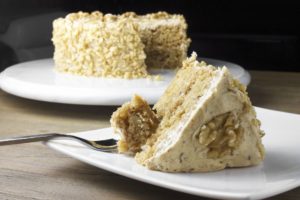Health Benefits Of Oat Flour

Health Benefits Of Oat Flour
Oat Flour Reduces the Risk of
Developing Heart Disease
One of the most compelling reasons to replace other cereal flours
in your diet with oat flour is the significant impact it has on cardiovascular
health and heart disease. Oats actually possess several properties that offer
a cardioprotective effect that minimizes the risk of developing heart disease.
Oat flour is a perfect gluten-free flour choice when a recipe doesn’t require
gluten to rise. It adds a rich, nutty flavor to any recipe. For example, it’s great
in cookies and makes them even chewier than normal. Also on the plus side,
oat flour tends to make baked goods more moist than wheat flour. It can be equally
exchanged in recipes for the following gluten-free flours: rice flour, millet flour
and sorghum flour.

Oat Flour Pancakes Recipe
Oat flour pancakes are one of the
easiest and simplest oat flour recipes
to make, as well as offering a delicious
and nutritious breakfast energy boost.
INGREDIENTS
Oat flour
¼ teaspoon salt
½ teaspoon baking powder
½ teaspoon ground cinnamon
1 egg, whisked
1 cup non-dairy milk
½ teaspoon vanilla extract
Small mixing bowl
Large mixing bowl
Skillet or non-stick pan
Instructions:
Mix oat flour, cinnamon, baking powder and salt in a
large mixing bowl and mix thoroughly.
Mix egg, milk, and vanilla extract in small bowl then
combine with dry ingredients.
Mix dry ingredients with wet ingredients thoroughly
and allow to rest for 5 minutes to create
pancake batter.
Heat skillet. Once hot, add ¼ cup batter for each
pancake. Cook until bubbles form on the
surface of the pancake, then flip over and cook until
both sides are golden brown.
Bonus tip: Raw cacao powder has a number of
powerful health benefits due to their high
content of cocoa flavonoids. Add raw cacao powder to
this recipe, along with stevia
sweetener to make delicious, sugar free chocolate
pancakes that deliver a huge
antioxidant boost. For more info, see our article on the
Health Benefits of Cocoa Flavanols.
Almond & Oat Flour Cookies
Oat flour, when used to make cookies, delivers
amazing results. The moist properties of
oat flour make it the perfect flour to use when making
non-rising baked goods. Combine
the nutty flavor of oat flour with almond in this recipe
to create long-lasting, healthy, and
delicious oat cookies.
What you’ll need:
1 cup oat flour
1 cup roasted almonds
½ cup maple syrup
Food processor
Large mixing bowl
Baking sheet
Instructions:
Preheat your oven to 350 degrees. While your oven heats up,
blend the almonds in the food processor on a low setting until
they reach a chunky consistency.
Mix the oat flour, roasted almonds, and maple syrup in the mixing bowl.
Separate the mixture into six clumps, then form these clumps into balls.
Flatten the cookie dough balls into cookies roughly ¼ inch thick.
Oil the baking sheet or use baking paper and place the cookies on it,
then place them in the oven for 15 minutes. Cook until golden brown,
paying attention not to burn them.
Remove the cookies from the oven and allow to cool.
More Health Benefits
Oat flour possesses a high antioxidant count,
with one particular antioxidant delivering powerful health-enhancing effects. Called avenanthramides,
or AVAs, these unique antioxidants are 10-30 times more powerful than other more common forms
of antioxidants and have been proven to promote heart health, as well as protecting the body from
heart disease, colorectal cancer and inflammation.
Oats typically contain 17 grams of dietary fiber per cup, compared to the average 4 grams in
a cup of processed wheat, offering a significant nutritive advantage. Diets rich in healthy fiber
have been conclusively proven to significantly reduce the risk of developing heart disease through
a multifaceted mechanism that simultaneously lowers cholesterol and inflammation while improving
insulin resistance, which is a key factor in the development of cardiovascular disease. The high fiber
content of oat flour protects the body from heart disease. Oat flour contains powerful antioxidants
called avenanthramides that improve heart health.
Oat flour and heart disease fast facts:

The benefits of the dietary fiber content of oat flour aren’t limited to the minimization
of heart disease, however. Roughly 5% of the total fiber content of oat flour consists of a
specific type of fiber called beta glucans, which have shown a great deal of promise in the
treatment of diabetes.
Oat Flour Reduces Bad Cholesterol Levels
High LDL cholesterol levels are linked to a wide variety of metabolic and cardiovascular disorders
as it builds up in the arteries of the heart. The beta glucan fiber in oats has been proven to have a
positive effect on blood serum levels of LDL cholesterol, assisting in cleaning
the blood vessels of buildup and reducing the risk of heart attack and obesity.
Three grams of this unique dietary fiber daily can reduce LDL cholesterol levels by between 5% and
10%, linking oats specifically with a 7% total reduction in LDL cholesterol in the body. This observation is
supported by another trial performed in 2006, which demonstrated a significant reduction in LDL levels
over a 6 week period in which participants supplemented their diets with 6 grams of beta glucan
daily.
Users need to consume about 50 grams of oat flour daily to receive significant health benefits.
The beta glucan fiber in oat flour dramatically reduces cholesterol. Oat flour fiber can reduce the
absorption of cholesterol from food.
Oat Flour is Low GI and Reduces Appetite
Oat flour also possesses a number of properties that make it an effective tool
for weight management, as well as a slow-burning superfood that can provide
long-lasting energy throughout the day. One of the primary causes of excessive
weight gain is excessive caloric consumption, which is, in turn, caused by
excessive dietary consumption.

Oats have been demonstrated to have a profound effect on the satiety mechanism
in the body, or the process that creates the sensation of “fullness” after a meal.
The glycemic index or GI of a food indicates the effect of the food on blood sugar levels.
A GI of 100 is equivalent to consuming pure sugar, which is wholly converted into blood
sugar. A low glycemic index food is metabolized at a slower rate, meaning energy is
provided to the body in a steady stream without spiking blood sugar levels. Oats have
an average GI of just 55, providing slow-burning energy that delivers healthy energy all
day long.
Oat Flour Can Lower Blood Pressure
High blood pressure can cause a variety of negative symptoms including migraines,
shortness of breath, anxiety, and even serious health disorders like cardiovascular
disease and dementia. The beta glucan dietary fiber that is unique to oat flour has been
demonstrated in at least three separate clinical trials to deliver a statistically significant
reduction in blood pressure, and even partly replace high blood pressure medication.
The oat beta glucan fiber as a treatment for high blood pressure found that just 4 weeks of beta glucan
supplementation can reduce the need for medication dramatically, halving the required dosage.
Oat Flour Nutritional Profile
Oats contain a significantly higher number of nutrients when compared to other
cereal grains. Let’s take a look at the nutritional value of 100 grams of oat flour:
100 grams of oat flour contains:
Roughly 18% of the total daily caloric intake, at 404 calories, of which is 60% carbohydrates
15 grams of protein, which accounts for 25% of the daily recommended intake
9 grams of healthy fats, which includes health-boosting omega fatty acids
Up to 8 grams of beta glucan fiber. Aside from these nutritional elements, oats also
contain high levels of vitamin B6, E, and K, as well as copper, zinc and potassium. Other
essential elements found in oat flour include folate, riboflavin, niacin, magnesium,
phosphorus, calcium, manganese, and thiamine.
Oat Flour Compared to Other Flours

Oat flour is the only grain flour replacement that can be used as an alternative by
individuals that are allergic to gluten or gluten intolerant, but there are a few other
types of flour that offer a number of advantages over traditional flours. Oat flour is a
great dietary supplement, but unfortunately can’t be used in baking recipes that
Let’s take a look at some healthy flour alternatives that, while still containing gluten,
offer a number of health advantages and see how they measure up to oat flour:
We wish to thank these folks for sharing this information with the world.
https://drmercola.com
https://draxe.com/oat-flour/
https://supplementpolice.com/oat-flour/
=========================
Where to Find Oat Flour & How to Use it
Oat flour is not generally carried in the average grocery store as it is still somewhat of
a niche product, but can be found in many organic food stores and health stores.
Currently, the best method of purchasing oat flour is online, with a variety of online
health food retailers carrying several major brands.
Individuals that are gluten intolerant should seriously consider making their own oat flour
from 100% pure oats to ensure there is no gluten contamination in the manufacturing
process, or purchasing oat flour only from certified, tested suppliers.
Oat Flour Recipes
The mild, nutty texture of oat flour and fine texture makes it great for use in any baking
recipe that doesn’t require the flour to rise, such as cookies and quick breads. Oatmeal
is already a popular additive in many cookie recipes, as it delivers a thick, chewy consistency
when baked, and oat flour delivers a similar effect. As an added bonus, baked goods
created with oat flour tend to be a little more moist due to the high moisture content of the flour.
There are some yeast products available on the market that are certified as completely gluten
free, so by adding these products to oat flour, it’s possible to create light and fluffy baked goods.
If you’ve decided to make a recipe that requires yeast with oat flour, you’ll need to add a little
more yeast than you would with normal flour. If using baking powder in a recipe, you’ll also need
to add a little more- 2 ½ teaspoons per cup of oat flour should suffice.
There are thousands of recipes in which you can substitute oat flour for gluten flour, creating
delicious and nutritious meals and baked goods that all deliver high amounts of beta glucan
fiber and critical nutrients, completely free from gluten. It’s even possible to make your own
oat flour at home using commonly-available oat brands if you can’t find oat flour in your
local retail stores.
Let’s take a look at some of the most popular oat flour
recipes:
Make Your Own Oat Flour
Making your own oat flour is easy and simple. The only ingredient required to make
oat flour is oats, which can come in any form- steel cut oats, rolled oats, quick cook oats
and old fashioned oats are all suitable, although gluten intolerant individuals should pay
special attention to the source of their oats to ensure they are 100% gluten free.
What you’ll need:
Oats- 1.25 cups of rolled oats creates 1 cup of oat flour, so keep this in mind when measuring
A food processor. An airtight storage container.
Instructions:
Begin by measuring out the amount of oat flour you
want to make.
Place the oats in a food processor and blend until the oats reach a fine,
powdery consistency. Dry oats only take about 30 seconds to reach this
point. If you don’t have a food processor, a coffee grinder will do in a pinch,
although you may want to clean it out first. If you’d like to do things the
old school way, you can use a mortar and pestle, although this takes quite a
long time.
Check the oat flour to make sure it has reached a fine consistency. If satisfied
with the texture, store the oat flour in an airtight container for later use Store
your oat flour in the refrigerator, as it has a small amount of fat content that
can cause it to spoil if left in warm, humid locations. It’s also possible to freeze
oat flour for long-term use.
Bonus tip: Consider adding a small amount of diatomaceous earth
to your oat flour to keep it safe from pests, prevent mold and fungus,
and add nutritional value. Diatomaceous earth is a naturally occurring
mineral and has a wide variety of positive health benefits. To find out
more, check out our Diatomaceous Earth Knowledge Base.
Oat Flour Health & Safety
Oat Flour Fast Facts
Oat flour is able to reduce your risk of heart disease, manage diabetes, lower
cholesterol, and minimize appetite Oat flour is extremely high in protein and
essential vitamins and minerals Oat flour has a low GI and can lower blood
pressure Oat flour can be used as a replacement for flour at a 1:1.25 ratio
There are no special considerations to take into account when using oat
flour, unless you suffer from celiac disease or are allergic to gluten.
If you possess a gluten intolerance or have celiac disease, keep in mind
that while 99% of the gluten intolerant and celiac population experience
no immune system response to the avenis protein in oats, it still has the
potential to cause a reaction in a very small subset of individuals.
If you’re making your own oat flour at home, be sure to use only 100%
certified gluten free oats. When purchasing oat flour online or in a retail
store, always check to make sure that the produce is 100% gluten free and
manufactured to strict quality and purity standards to avoid gluten
contamination.
As a final note on safety, you may experience some bloating or gas when consuming oat flour
if you don’t normally consume oats, as your body will need to adjust to the increased fiber
content of your diet.
The Bottom Line Regarding Oat Flour
If you are celiac or gluten intolerant, oat flour is a highly nutritious, tasty, and effective replacement
for wheat flour and other gluten flours. If you don’t possess celiac disease or gluten intolerance,
switching to oat flour is still a great way to improve your overall health due to the high beta glucan fiber
content of oats. But you need to follow recipes designed to bind oat flour baked goods.
We thank these folks for sharing this information with
the world.
https://draxe.com/oat-flour/
https://supplementpolice.com/oat-flour/
Almond Flour
Like coconut flour, almond flour is another gluten free flour that can be used as an
alternative by gluten intolerant individuals. Also known as almond meal, almond flour
is made by grinding up dried sweet almonds. The extremely sweet flavor of this flour
makes it great for using in baked goods and desserts, and also contains a low level
of carbohydrates.
One cup of almond flour contains 640 calories, making it the most calorie-dense flour
on this list, which is mainly due to its high sugar content at 18 grams per cup, which is
half the recommended daily intake. Despite the high sugar content of almond flour, it has
the advantage of containing high levels of omega 6 fatty acids, which promote heart
health and minimize inflammation.
Similarly to coconut flour, almond flour contains FODMAP carbohydrates, which can cause
digestive issues in some people. Compared to oat flour, the sugar content and absorbent
nature of almond flour make it somewhat less attractive, unless used as a sweetening
flour to gluten-free non-rising baking recipes.
Coconut Flour
Coconut flour is another great alternative flour
for gluten intolerant individuals
It contains no inherent gluten. Made from the dried and pulverized pulp of the coconut, coconut
flour is high in fiber, containing almost twice the amount found in bread wheat flour.
While this high fiber content is great for the daily intake, delivering 20% of the RDI,
it can make cooking somewhat difficult, as it absorbs so much moisture.
One cup of coconut flour contains 480 calories, 16 grams of fat, 16 grams of protein,
40 grams of fiber and 8 grams of sugar, which is about 40% of the daily sugar intake.
As a replacement for gluten grains, oat flour is generally superior to coconut flour as it
contains far less sugar and is less absorbent, as well as offering a better nutritional profile.
Another factor that may lead you to consider oat flour over coconut flour is that the fiber
in coconut, inulin fiber, is a FODMAP carbohydrate that passes through the digestive
system in large amounts and ferments in the colon, causing bloating, swelling, and gas
in some individuals. The effect of FODMAP carbs vary from person to person, however,
and some individuals experience no digestive discomfort.





You must be logged in to post a comment.